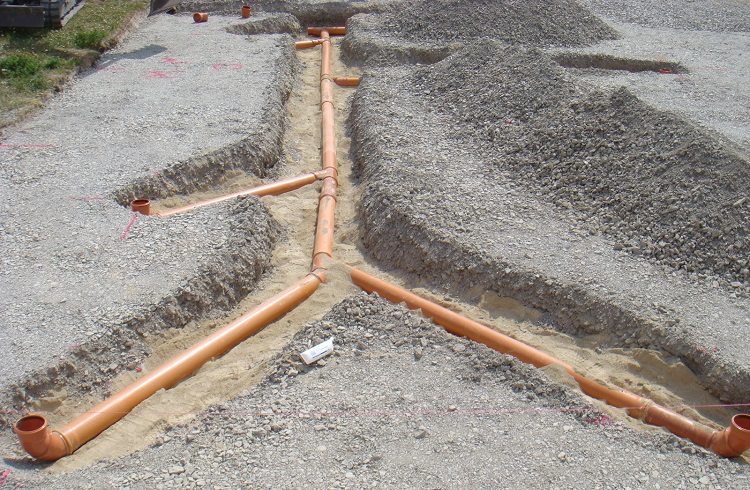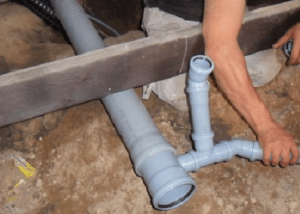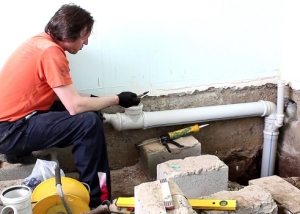It is impossible to create comfortable living conditions in a private house or apartment without sewage. Such systems are an integral part of our everyday life. Initially, sewage is transported through internal pipelines to external pipelines, eventually reaching septic tanks or storage tanks. But only the correct installation of sewer pipes will ensure the full utilization of human waste.
Content
The choice of materials for installation
For such purposes, it is allowed to use products made from various raw materials. Not so long ago, the laying of the external sewage of a private house was carried out exclusively cast iron pipes. Today, the installation of an external network is carried out, as a rule, using polymer products. This is due to the fact that cast iron is not so durable compared to plastic and cast iron products are very heavy. So in this case, the choice of technology for laying sewer pipes in the ground, as a rule, involves the use of special equipment.
Plastic sewer pipes favorably differ not only in low weight. They also have the following advantages:
- easily withstand the effects of chemically active substances;
- not subject to corrosion;
- smooth inner surface. Due to this property, deposits are not formed in the pipe cavity, leading to a decrease in the throughput of the pipeline.
When laying sewer pipes in a trench, the above properties are important because repair, replacement or their cleaning will require land work. And this is a loss of time and additional costs.
In addition, plastic products have the following properties:
- do not conduct electric current. Today this is especially true, because in a modern private house or apartment there are various household electrical appliances;
- absolutely non-toxic;
- inexpensive;
- can form highways of various configurations. But without knowledge of how to properly lay the sewer pipe in the trench, you will not be able to take advantage of this advantage.
In addition, during operation, plastic products do not lose their pretty decent appearance. So laying sewer pipes in a private house or apartment, even if they are not painted, will not spoil the interior of the bathroom or the bathroom. And in the kitchen, pipes are usually hidden in a floor cabinet under the sink.
Helpful advice! When laying the sewers in the apartment with your own hands, use gray plastic pipes. The arrangement of the external sewage system of a private house is carried out using polymer products of orange (brick or red) color.
Sanitary regulations
Do-it-yourself installation of sewer pipes in an apartment or private house should be carried out in accordance with the requirements contained in the Sanitary Standards and Rules of 1985. There are also recommendations for the production of work related to pipeline depths into the soil and other equally important information regarding how to properly lay sewer pipes in the ground.
In this regulatory document, in particular, it is said that the depth of the pipe should not be less than 30-50 cm from the level of soil freezing in a particular region (the distance is calculated from the bottom of the pipeline). If the laying of sewer pipes is carried out in areas with a high load on the soil surface (for example, under roads), the pipes will have to be laid deeper (up to 9 meters).
Laying sewer pipes in the ground should be based on the following principles:
- In places where you plan to build a drainage system for a private house, be sure to compact the soil. This will prevent erosion of the communication by groundwater during heavy precipitation.
- The laying of the external sewage system will be carried out correctly only if the optimal slope of the highway is observed. It should be 1-2 cm for each linear meter of the pipeline. The need to fulfill this requirement is due to the fact that there is no pressure head in a domestic wastewater disposal system. Thus, in the absence of sewer pipe slope sewage will not move to the septic tank, drain pit or drainage well and the line will very quickly become clogged with all the unpleasant consequences resulting from it.
- The technology for laying sewer pipes in a private house provides that where a highway makes a sharp bend, a special well must be installed in the trench. This will also simplify the repair work and will allow you to quickly replace the damaged segment of the pipeline.
There is another important rule regarding how to lay a sewer pipe in the ground. Its observance will ensure the reliability and ease of operation of the system. It sounds like this: the bottom of the trench must be covered with a layer of sand with a thickness of at least 15 cm. It is recommended to fill the pipeline with the same layer from above.
This backfill will prevent difficulties in accessing the pipes if repairs are needed.
Helpful advice! Mount observation wells also in those areas where significant differences in the depths of the sewerage are noted. In addition, if the network length is large, install several of them at a distance of 25 meters.
Laying sewer pipes. Sequencing
Before laying sewer pipes in a private house, you need to dig a trench. This can be done using special equipment (for example, an excavator) or manually. Regardless of the method, digging should be in compliance with the standards for the width and depth of this moat.
Laying sewer pipes according to generally accepted technology involves the use of pipes with a diameter of 110 millimeters. The width of the trench in this case should be at least 60 centimeters. With a larger section of pipes, the width of the ditch also increases.
And one more important point that must be taken into account if you want to lay the sewer of a private house correctly. This work should begin from the foundation of the structure. In the case when there is no pipe outlet from the house, cut a hole under the foundation and feed the line under it. If there is a conclusion, put a bell on the end of the pipe that exits the building. In this case, pay special attention to the alignment of the connected elements of the sewage pipeline.
In most cases, throughout the sewage disposal system there are turns and bends, which are one of the main reasons for its failure. It is there that deposits begin to appear, completely blocking the path to utilized sewage. Experienced craftsmen, of course, know how to lay sewer pipes in a private house in order to prevent this phenomenon. Therefore, it will be useful to listen to the advice of professionals. They can be summarized as follows: it is necessary to lay sewer pipes using bends having different angles - from 15 to 90 degrees. And in order to ensure ease of access to potential places of blockages, it is recommended to mount revisions above all knees.
After the conclusion from the house is formed, lay the pipes in the trench with the bells down and proceed to them connection. Do it this way: lubricate the edges with a special substance and place the pipes in the socket to the stop. To reliably and correctly connect the elements of engineering communication, and no matter what - a private house or apartment, you can use one simple trick. It consists in preliminary drawing marks on the pipes that determine the depth of their entry into the socket. In accordance with them and make the final connection. After all the segments are connected, proceed to work on sewer pipe insulation. This is necessary if the pipe laying depth is in soil layers that freeze at low temperatures.
At the final stage of installation of external sewage, fill in the trench. Backfill technology involves checking the incline of the system. Indeed, in the process of connecting all the elements, this indicator may change.
Helpful advice! If you will fill up the soil that appeared during the digging of the trench, grind it and get rid of large inclusions. It is forbidden to use soil that contains solid blocks or stones larger than 30 centimeters in size, since the probability of damage to plastic pipes by them is quite high.
Not knowing how sewage is laid in a private house correctly, many of our compatriots pay little attention to this stage. However, it must also be carried out in compliance with certain requirements. The main one is: filling the trench with earth should be carried out in layers of a thickness of about 5 centimeters. Tamping them should only be on the side of the pipeline. This will eliminate the possibility of deformation or damage to the pipes.
And a few words about how sewer pipes are laid in a private house and in an apartment. In principle, the approach to solving this problem is identical. After all, wastewater appears in the living room and only then it is brought out.
So, if we talk about the layout of the pipes of a country cottage and a modern apartment, then the following requirements must be met:
- observe the angle of inclination of the pipeline;
- minimize the number of turns and bends.
Since household sewage is pressureless, it is allowed to use a simple socket connection when assembling the pipeline. Its sealing is carried out using a rubber cuff. Place it in the internal groove of the socket before starting the connection procedure.
The main difference in the approach to solving the problem of how the sewage of a private house and apartment is laid is only in the fact that in the first case there is an external part - a pipeline laid in the ground, leading to a septic tank or to the main sewage main.
In any case, you can do this work yourself. Subject to all recommendations of professionals, the reliability of the sewage system will be high and the service life will be long.











